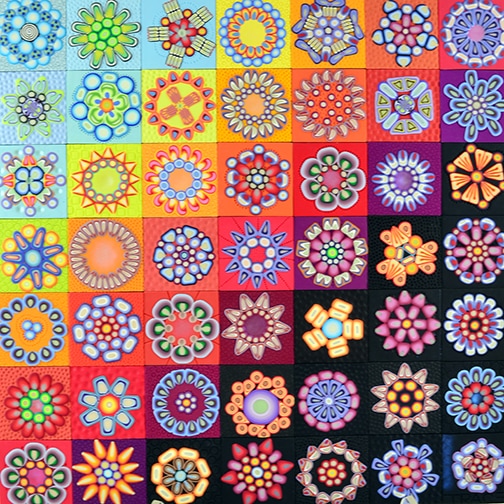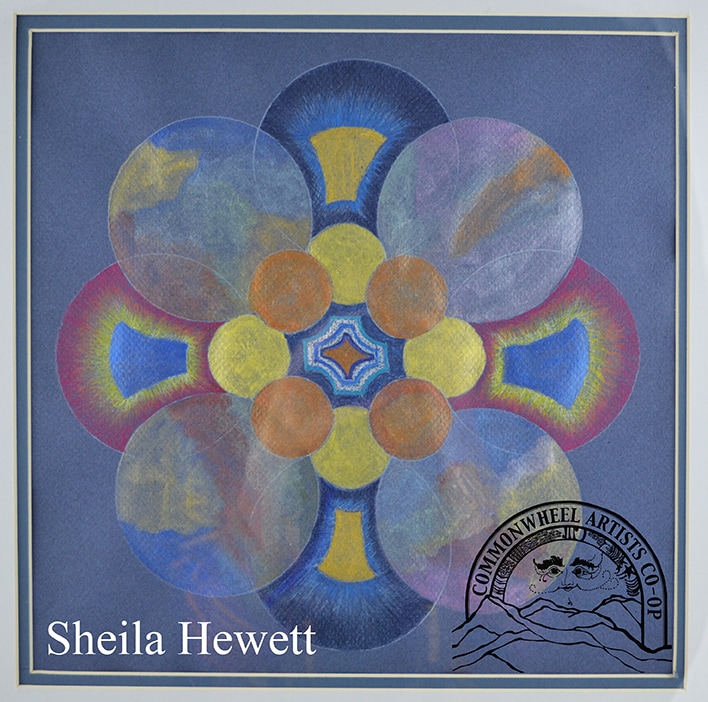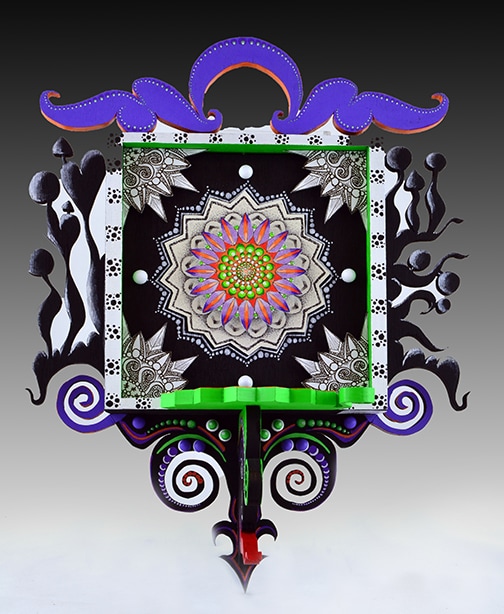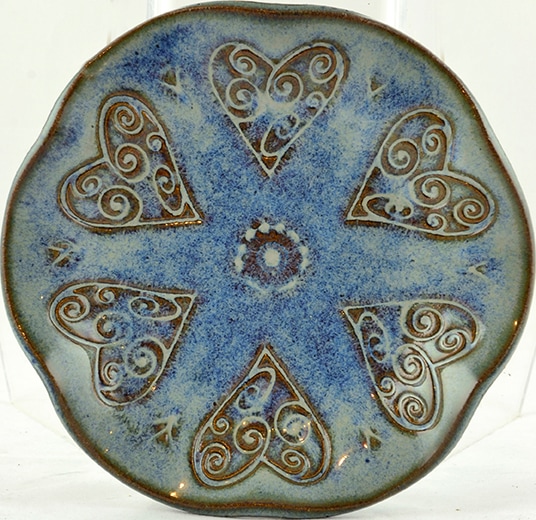|
Ray Jordan is one of our newer co-op members, joining us after last spring’s “Mandala” show. Be sure to take advantage of our Artist of the Month discount on Ray's work when you're in the shop. Tell us a little about yourself. Art, in some form, has been part of my life since I was a small child. My grandfather was a master carpenter and he shared his creative spirit and love of sawdust with me at a very early age. In high school I took every art class that was offered along with wood shop and I explored various artful endeavors (quilting, silk-screening, printing press, sketching, painting, etc.) creating things for my home, family and friends. More recently I added acrylics and began producing colorful, 3D, themed pieces adorned with intricate scroll saw cutouts. Finding this artistic voice provided the focus, motivation and confidence to share my art with the outside world. How long have you been part of Commonwheel? I joined the Commonwheel Co-op in May of 2017, so it has been just over a year with the artist co-op. What does making art mean to you? Making art to me is an amazing journey into the depths of my consciousness, digging deeper and deeper to find more and more interesting ideas, and ways to express myself through art. I love coming across a new idea, and exploring that idea to its fullest potential, and hopefully be amazed with the output/artwork. What are you currently working on? Currently I am working on 8x10 sized print pieces that have 3-D flower mandalas in the middle along with some accent pieces. I am also working on a series of new Pendulum Clock pieces, as well as some smaller to medium sized flower Mandala Boxes. Tell us about your process-- Walk us through the steps of your flowing creativity to achieve one of your works. I've been asked this before, and it is a hard thing to explain. I'm not sure where everything comes from, other than a good idea that comes into my mind, and through the process of thinking of how to accomplish a certain piece, Magic happens? I start with a drawing from my sketch book most of the time, from there, images get drawn on wood, and cut out with my scroll saw. Then color comes into play with paint. I choose a very bright palette most of the time and try and create something I can be proud of. What reactions do you want the public to have when looking at your artwork? Honestly, I want the viewer to find their own inspiration in my work. Maybe it reminds them of something from their childhood, or a place in time from the past. I will leave all that up to the interpreter. What is your favorite piece recent work? And why? My favorite recent piece of work is my 8x10 mandala prints with the lotus flower in the middle. It was just fun to make, I drew up a pencil sketch, went over it with black ink, then colored with Prisma color pencils with shading. I don't get to draw every day, usually painting or putting things together that are already cut/made. So, starting from scratch with a new idea, is always exciting. Anything else you’d like to tell us about yourself? I love the outdoors in general. I play amateur adult baseball in Colorado Springs. I love to hike, rock climb, snowboard, plant gardens/flowers, mountain bike, go to art festivals, and hang out with good friends. I also love to quilt, make mosaics, cook, play frisbee or bocce ball, play pinball, and all the other amazing activities that life has to offer. Where can we find your work? Pretty exclusive so far, just Commonwheel and my website TrippyTrixter.com. I do plan on attempting to get into a few more art galleries this year.
0 Comments
by Leti Wesolowski We put out a call for mandala-related art and our local artists stepped up to the challenge. The “Mandala” show currently in our gallery is the result. 17 artists brought in mandala-related art from diverse points of views and inspiration—from patterns of nature, symbols from different cultures, colors, and the practice of centering and meditation. The works explore multiple medias but all embody the concept of “mandala”: fused glass; watercolor; digital photography; bronze, silver, and copper; precious metal clays; mixed media; stained glass; laser-cut wood; hand stamped clay; polymer clay; engraved terracotta; vinyl records; color pencil drawings; and more. We invite you to contemplate mandalas made by local artists and discover which one evokes feelings of peace, balance, unity and strength that resonate with you. Let them work their magic on your life and allow your mind to wander into the beauty of mandalas. “Mandala” comes from a Sanskrit word that means “circle or disc”. In art, mandala is often a symbolic pattern usually in the form of a circle within a square divided into four symmetric sections containing a unifying center from which geometric shapes and symbols radiate outwards. “The mandala is an archetypal image whose occurrence is attested throughout the ages. It signifies the wholeness of the Self.” —Carl G. Jung, Memories, Dreams and Reflections Embraced by many religions and cultures around the world, a mandala represents wholeness and the connection between inner self and outer reality. “In Christianity, there are a number of sacred images and ritual invocations that use the circular shape to connect the spiritual realm with the earthly realm”, says figurative sculptor Marica Hefti. “The placement of divine beings, angelic figures, and holy personages at crucial positions within the circular (stained glass) windows (of Christian cathedrals) establishes the powerful storyline of Christian beliefs”. Hindus were one of the first people to use mandalas as spiritual tools. Native Americans use mandalas as shields of good luck, prosperity, wealth and happiness. Buddhist monks create sand mandalas, a process that takes days to create, then sweep it and pour it into a river, to symbolize the never-ending cycle of life. “A concept of new beginnings, forms of life itself” says Tracey Eastland when asked to explain what a mandala means to him. Mandala is used in spiritual practices as a focal point for meditation, self-awareness, and healing. For digital photographer Teri Rowan, a mandala is “meant to inspire meditation and introspection” or can be admired for just its beauty. Metalsmith Kathleen Krucoff thinks a mandala is “a beautiful symbol to convey positive messages of encouragement and support”. In art, mandala has become a generic term for any diagram, chart, or geometric pattern that represents the center of the universe, metaphysically or symbolically. For Jewelry artist Connie Lorig, a mandala represents “a complex dance between unity and diversity, between the parts and the whole.” For artist Sheila Hewlett, mandala means the continuity of life. Commonwheel artist Julia Wright takes pictures of nature during her hikes and then edit them on her computer to create hypnotic mandalas. Designing a mandala is a unique personal experience in which the individual lets the creative mind to run free and find the symphony of shapes, colors and patterns to represent their unique sense of self and view of reality. Sculptor m.jo hart says “mandalas represent the process and meditation involved in creating her work”, which is focused on women’s issues, unique stories and experiences. Mandalas can be created by individuals to symbolize their journeys through life, their state of mind or to tell their personal story. Some of our artists got inspired by Celtic art, such as lampwork artists Jon Murray and Amanda Shotts who incorporate in their mandala barrettes “a circular pattern that has no beginning and no ending, signifying infinity of love!” Or Glass artist Sabine Wachs who “was drawn to the Celtic spiral mandalas used as symbols of the sun powering all life”. Jeweler Mary Cowdery got inspired by the yin-yang symbol, repetition and balance. Artist Ray Jordan loves bright whimsical colors. His biggest inspiration is combining bright colors with his love of painting, drawing and cutting wood. Kendrick Cowdery has a strong desire to maintain peace in his life. His handmade mandala lamp is built on mat board using a laser cutter and colorful translucent paper. Several artists took it as a chance to explore new themes and materials, such as mosaic artist Juanita Canzoneri who jumped at the opportunity to play with alcohol inks and raid her stash of stained glass. She found that, during the process, mos of her work reminded her of an art form from her childhood in eastern Pennsylvania. Others worked in new themes with their primary media, such as potter Jennifer Hanson who creates mandalas on her clay dishes with different hand stamps. Or illustrator and mixed media artist Kelly Green who finds that vinyl albums automatically lend themselves to the mandala format. Creating a mandala can be an enriching personal experience. To draw a mandala, one starts by “drawing the circle, setting an intention, centering through a meditation, usually start at the “bindu” sacred center and follow inspiration that comes” explains Mandala instructor Anne Roe. She sees mandalas “as “windows to the soul”, sacred circles and opportunities for the soulful self to express authentically”. Sometimes mandalas are created to evoke feelings of peace and contentment on the observer. Kathleen Krucoff, for example, wanted her pieces to “help the wearer feel empowered” focusing in tranquility and strength. Ray Jordan wanted to “bring a smile to the art viewer mind and make them think”.
|
Juanita Canzoneri
|




















 RSS Feed
RSS Feed